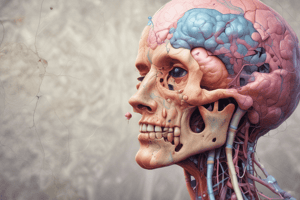Podcast
Questions and Answers
What term refers to the lack of differentiation in neoplastic cells?
What term refers to the lack of differentiation in neoplastic cells?
- Pleomorphism
- Dysplasia
- Anaplasia (correct)
- Metastasis
What is the primary characteristic of in situ carcinoma?
What is the primary characteristic of in situ carcinoma?
- It invades surrounding stroma
- It consists solely of benign neoplastic cells
- It shows extensive pleomorphism
- It remains within the epithelium (correct)
Which statement about benign neoplasms is incorrect?
Which statement about benign neoplasms is incorrect?
- They resemble their tissue of origin
- They are likely to invade surrounding tissues (correct)
- They remain localized at the site of origin
- They are generally slow-growing
Which feature describes cells found in a state of pleomorphism?
Which feature describes cells found in a state of pleomorphism?
What does hyperchromatic appearance in neoplastic cells indicate?
What does hyperchromatic appearance in neoplastic cells indicate?
What is a key characteristic of mesenchymal neoplasms?
What is a key characteristic of mesenchymal neoplasms?
Why do hematopoietic neoplasms not need to access basal membranes?
Why do hematopoietic neoplasms not need to access basal membranes?
What happens to brain tumors due to limited space in the skull?
What happens to brain tumors due to limited space in the skull?
What are induced pluripotent cells?
What are induced pluripotent cells?
Why is cancer considered a multifactorial disorder?
Why is cancer considered a multifactorial disorder?
What is the difference between stratified medicine and traditional medicine?
What is the difference between stratified medicine and traditional medicine?
What characterization distinguishes benign tumors from malignant tumors?
What characterization distinguishes benign tumors from malignant tumors?
How does stratified medicine aim to improve cancer treatment?
How does stratified medicine aim to improve cancer treatment?
What is indicated if both the positive control and negative control show expected results in an experiment?
What is indicated if both the positive control and negative control show expected results in an experiment?
What happens to the number of cells during the process of neoplastic disease?
What happens to the number of cells during the process of neoplastic disease?
Which of the following describes the term 'hyperplasia'?
Which of the following describes the term 'hyperplasia'?
What is the typical percentage of cancers that are classified as carcinomas?
What is the typical percentage of cancers that are classified as carcinomas?
What happens to the shape of cells during their differentiation in the context of neoplastic diseases?
What happens to the shape of cells during their differentiation in the context of neoplastic diseases?
Why are some proliferations considered borderline states?
Why are some proliferations considered borderline states?
Which phase is associated with abnormal proliferation where cells may not undergo sufficient division?
Which phase is associated with abnormal proliferation where cells may not undergo sufficient division?
What characterizes the cell size within neoplastic growths?
What characterizes the cell size within neoplastic growths?
What characterizes a more differentiated cell compared to an anaplastic cell?
What characterizes a more differentiated cell compared to an anaplastic cell?
Which feature is indicative of pleomorphism in tumor cells?
Which feature is indicative of pleomorphism in tumor cells?
Carcinomas predominantly spread through which pathway?
Carcinomas predominantly spread through which pathway?
What is associated with leiomyoma cells?
What is associated with leiomyoma cells?
What identifies an adenocarcinoma based on its cellular features?
What identifies an adenocarcinoma based on its cellular features?
What does a follicular adenoma typically contain?
What does a follicular adenoma typically contain?
What does loss of polarity in tumor cells indicate?
What does loss of polarity in tumor cells indicate?
What is a common characteristic of squamous epithelium in abnormal conditions?
What is a common characteristic of squamous epithelium in abnormal conditions?
Flashcards are hidden until you start studying
Study Notes
Characteristics of Benign and Malignant Tumors
- Initial step in experimentation involves formulating questions and hypotheses, setting controls, checking results for consistency with expectations.
- Tumors arise from prolonged processes of abnormal cell division and proliferation, characterized by increasing cell numbers and decreased cell size.
- Differentiation of cells alters their shapes; abnormal proliferation occurs when differentiation is limited but cell division is excessive.
- Borderline states, such as hyperplasia, reflect increased cell numbers without being classified as neoplasms.
- Carcinomas account for approximately 80-85% of cancers, while mesenchymal neoplasms exist within the stroma and can lead to hematogenous metastasis.
- Hematopoietic neoplasms reside in the vascular structure, often detectable via blood counts, revealing elevated white blood cell levels.
- Brain tumors can cause significant pressure due to limited cranial space, resulting in critical organ effects without traditional metastasis.
- Induced pluripotent cells can be created from mature differentiated cells by applying differentiation factors.
- Cancer results from genetic disorders, often influenced by environmental factors, highlighting its multifactorial nature.
- Stratified medicine tailors cancer treatment based on stages, emphasizing personalized approaches over traditional methods.
- Benign tumors closely resemble their original cell types, are well-differentiated, do not invade surrounding tissues, and do not metastasize.
- Pleomorphism refers to variations in tumor cell size and shape, indicative of malignancy, alongside abnormal nuclear morphology.
- Loss of polarity in tumor cells occurs when nuclei relocate to apical portions of cells.
- Carcinomas typically spread via lymphatic routes, while sarcomas disseminate hematogenously; some cancers may utilize body cavities.
- Different tumor types exhibit distinct histological and growth patterns, e.g., leiomyoma presenting spindle cell morphology with no mitotic figures.
- Adenocarcinoma features irregular cells with hyperchromatic staining, inflammation, and necrosis, indicating invasive properties.
- In situ carcinoma remains within the epithelium without invading the stroma, showing signs of abnormal growth and cellular features.
- Differentiation indicates the resemblance of neoplastic cells to normal cells, where a lack of differentiation is termed anaplasia.
- Benign neoplasms are well-circumscribed, typically local, slower growing, and resemble their tissue of origin, retaining functional characteristics.
Studying That Suits You
Use AI to generate personalized quizzes and flashcards to suit your learning preferences.



